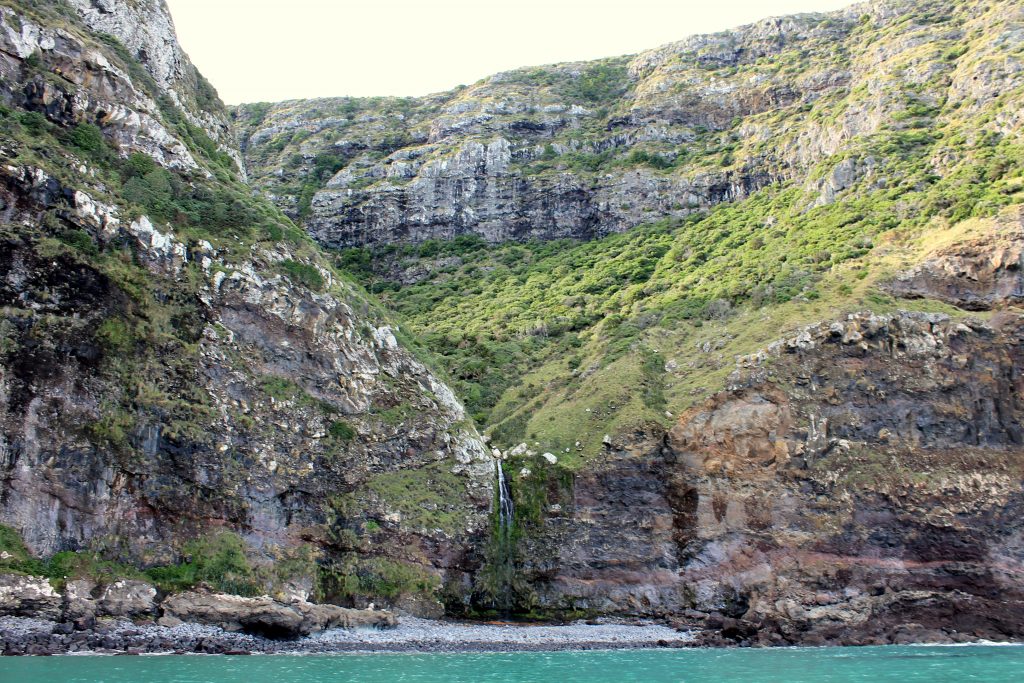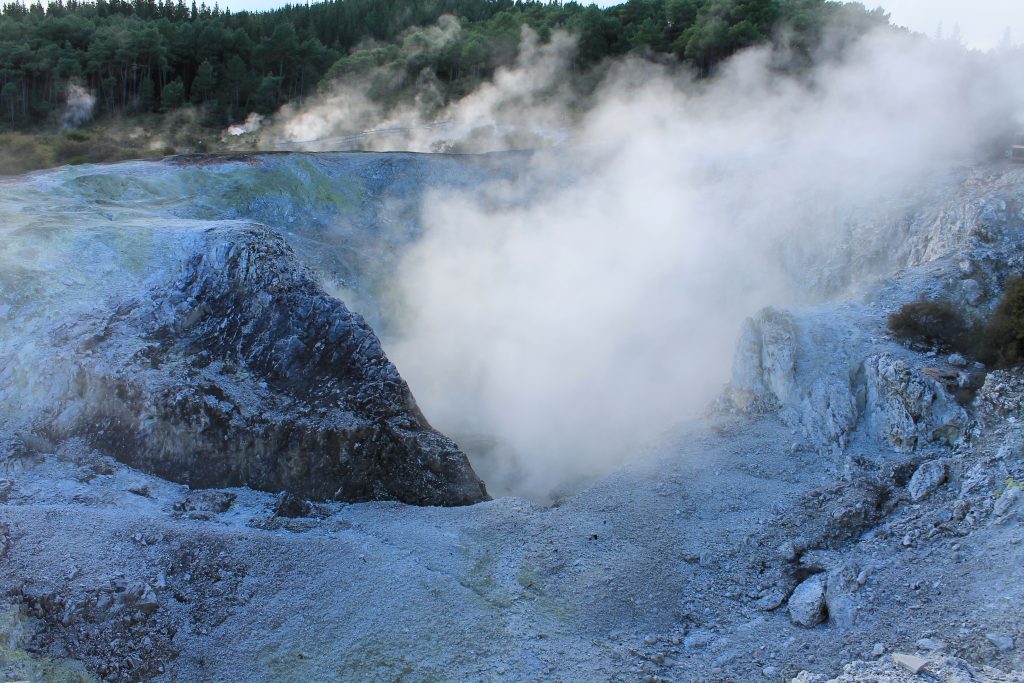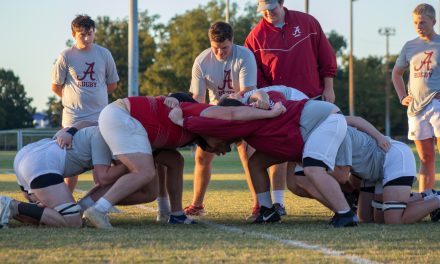
Ben Rogers
Journal Entry - Movie Review #1 - Hunt for the Wilderpeople
This was the first of the pre-departure movies that I watched and I have to say: it was amazing. It made me excited to get to go and visit such a beautiful country and curious about the parallels between our two countries. Not to mention that it was also just a really cool movie that had a great story line and used amazing camera work to showcase the beautiful, vast jungles that cover the Islands.
The setting of this movie made me so excited to get to travel to such a beautiful and lush country. Every shot from the amazing aerial shots that put on full display the gorgeous green, tree-covered mountains of New Zealand to the shots of the rolling country side made me want to get out and explore this amazing country. When the movie ended I found myself wanting to just go and camp in the woods of New Zealand for a month because they’re just so cool and full of life that I’ve never seen before.
The second thing about the movie that I liked was how it got me thinking about the similarities that may run between our countries. Watching how Ricky and his social worker interacted made me think of how that dynamic is often paralleled in the US. Which got me thinking, “In what other ways are we similar?” I can’t wait to go and figure out how our cultures differ but also how they are alike.
The last thing that I really liked about this movie was just how good of a movie it was. I enjoyed how it was never really easy to guess what was coming next in the story. The movie was full of different twists and turns, as any good story should be, but these changes in direction weren’t overly foreshadowed to a point where you can guess what’s going to happen in a movie before it happens. I also really liked the story-line itself. Watching Bella get Ricky to open up and just be a happy kid and then getting to watch Hec slowly open up to Ricky was really heartwarming.
Movie Review #2 - Pork Pie
This was yet another amazing movie. I’m a big fan of movies with great car chases (because at heart I am a child who thinks recklessly driving a car is super cool) and this movie was in effect one big car chase. The movie was also riddled with really good, comedic dialogues that helped keep it from becoming something like a Fast and Furious movie where everyone is super serious all the time.
I enjoyed how even though the purpose of the characters in this movie was to get Jon reunited with his long lost love the writers didn’t make the entire movie just about that one goal. They gave each of the three characters a purpose of their own which for some reason sucked me in and I couldn’t stop watching.
As stated earlier, I really liked how situational irony was used to introduce some humor into the story to keep it light and happy and how Jon was always ready with some snappy comeback that lifted the mood of the characters and the audience after something would go wrong.
Both of these qualities of the movie came together to make an amazing movie that had me interested the entire time.
Album Review - Harmony House by Dave Dobbyn
Dave Dobbyn is an amazingly talented artist. I was unfamiliar with his work before listening to this album, but after listening to it multiple times through I think I may have to listen to more of his work. The first song on the album, “Waiting for a Voice,” is probably my favorite of the entire album. It has a very island feel to it (or at least it does to me) that is found throughout the album whether that be through some really wavy string bending or the use of drums to make rhythms that for some reason make me want to just sit on a beach. That being said the entire album isn’t just super mellow beach vibes; songs like, “Angelina,” really have a Bruce Springsteen-like feeling to them that I really enjoy. I think it has something to do with how the guitar is used or the way his voice sounds but when I first heard it I thought I must be listening to the New Zealand version of The Boss. The album as a whole really sticks to these two main points: how to use his wide range as a singer and this relaxed vibe. However, that isn’t to say that the entire album is just a Springsteen-Beach Boys mash up. While the album mostly stays close to these themes, Dobbyn isn’t afraid to experiment and make each song sound different from the last.
Blog Post #1
There are a multitude of differences between Auckland and the United States. Of these differences the one that stuck out to me the most was the thriving and diverse community that has been created between immigrants and native New Zealanders.
As you enter the city one of the first things that I noticed was the vast array of restaurants and shops that are from various parts of the world that you don’t necessarily associate with New Zealand. It’s not so much the number of these businesses that is surprising, but instead that these businesses are intermingled and dispersed throughout the city. There really is no “Chinatown” or “Little Havana” where you can find all the businesses that are run by and targeted toward a specific group of people. After I saw this trend of businesses I was interested to see if this idea of a fully integrated city was shared by Aucklanders or if these shops had just gone where they were because the rent was cheap.
Luckily, I was able to test this theory a few days later when we went to AUT (a local university in Auckland). While there I was able to ask multiple students about where they lived and their answers seemed to confirm what I thought but they also said something that was very American in nature but executed better than in the States. Of the five students that I spoke with, all of them seemed to agree that while they tended to live close to family and that caused their neighbors to sometimes be a little bit like themselves for the most part their neighborhoods were pretty ethnically diverse. They also said that living in an ethnically diverse community was pretty much the status quo for Auckland.
One thing that the students said that stuck out to me as sounding vaguely American was that in New Zealand it was expected that you assimilate into their culture; this includes learning their language and customs etc. This idea that you must assimilate in order to be accepted by your new home is one that most in the United States would agree with, but there is a difference in how we go about assimilating and how they go about it. New Zealanders seem to be very open to people maintaining their cultures just as if they had never left their home countries. This idea of allowing people to maintain their cultures as they are feels a little foreign to me because in the US we like to refer to ourselves as this “Cultural Melting Pot” which is good in the sense that it brings people together but can also act as a force that brings people away from their heritage. In the US people are often faced with the decision of giving up many of their own traditions in order to pick up new, American ones.
As we continue to explore this beautiful, vast, and diverse country I look forward to exploring whether this idea of allowing people to peacefully coexist and keep their traditions continues or if it is a sentiment that is only felt within Auckland.


Top Photo: Taken at Onetangi Beach on Waiheke Island
Bottom Photo: Taken from the 52nd floor of the Sky Tower in Auckland overlooking downtown Aukland
Blog Post #2
In the time that has elapsed since my first blog post we’ve travelled throughout rural parts of the North Island and we flew to Christchurch in the South Island. During this time, I’ve continued to focus on how immigrants and foreigners in general are viewed outside of Auckland. For the purposes of this blog I will mostly be focusing on my time in the South Island.
Just like when we went to the North Island, I really didn’t know much about the South Island or what to expect from my time there. Before leaving North Island, I had a conversation with our bus driver/ tour guide/ fellow rugby player, Darryl, about what to expect when I got to the South Island. He told me to expect a very English community and city. He couldn’t have been more spot on. Even though the city suffered from a series of earthquakes in 2010 and 2011 the city is still filled with English looking buildings. And the more I talked to the people the more I saw that they were very English in the way that they acted and carried themselves. One of the best examples of this is the amount of emphasis that they put on where you went to high school which is unique to Christchurch. While we were in Christchurch we met with a student named Selwyn who told us that people will scoff and pass judgement about you based solely off of which high school you attended. This attitude that where you come from says something about you or whether someone should be friends with you is something that I’ve seen a lot with my friends who are from Britain.
Another thing that is very peculiar about South Islanders, when compared to the people we met on the North Island, is their view on foreigners (people who aren’t white). In our talks with Selwyn, who is half Tongan half white New Zealander, he talked about how Christchurch was very similar to America in how we deal with foreigners in that the natives expect immigrants to assimilate and be just like the English New Zealanders. The example he gave was when Tonga played New Zealand in Rugby, the Tongan fans were on their feet, stomping, and chanting, “Tonga or Die!” This angered the English New Zealanders including the staff who told the Tongan fans to sit down and be quiet. This idea of sitting quietly and watching the game with cheering reserved for scores is considered to be the proper way to watch a game by the staff. Through talking to Selwyn, I found that this was a good metaphor for how foreigners are treated by the English New Zealanders; they’re ok with you eating food from your country and speaking your native language at home, but in public you need to speak English and conform to the New Zealand way of doing things. This was so different from Auckland and Selwyn even acknowledged this in our conversation. According to him Auckland is a very open and accepting place where you’re free to be who you are, but in Christchurch you are expected to fully assimilate into their culture.
Another parallel that runs between the US and South Island when it comes to views on immigrants is that there are a lot more negative stereotypes associated with various groups than in Auckland. One really good example that Selwyn gave of this was how when people don’t know that he’s half Tongan they often say derogatory statements around him about the Tongan people like, “Tongans are a bunch of thugs.” None of these are based in truth and are mostly based on peoples fear of the unknown. I see this a lot in the States as well, when they don’t have direct contact with people of different ethnicities in their community they start to make stereotypes about them. This is super evident in the South where we are pretty ethnically similar (mostly white) and stereotypes about people who aren’t of the same ethnicity abound. A key example is in the South, Mexicans get blamed for a lot of the problems experienced in southern communities like drugs, lack of jobs, and crime when in reality they don’t make up a large part of the population. Most of the time they are just used as a scape goat and sadly it works because a lot of people don’t interact with them on a daily basis which causes them to be easily stereotyped. This is basically the same thing that is happening in Christchurch; immigrants are wrongfully blamed for causing the cities problems
It’s been really interesting to see this stark contrast from Auckland and Christchurch. They are the two biggest cities in this country but couldn’t be more different with respect to culture and acceptance. It was also thought provoking to see the parallels that run between our country and Christchurch. It makes you think deeply about things that you used to just assume were true like which side of town is nicer or worse and which one was less safe. For some reason it took having someone in a gelato shop on the other side of the Earth talk about how people are stereotyped unfairly to make me think about whether that goes on in my community.

A really pretty view from our sailing trip of a natural spring pouring into the bay at Akaroa.

Sulfur Springs on the North Island. Words don’t do justice how bad it smelled
Blog Post #3
For my final blog post I decided to move away from focusing on New Zealanders’ stance on immigration, and instead focus on a theme that I’ve seen throughout the country regardless of location or ethnicity. That theme being the care they show toward their environment. They do this in a multitude of ways: not littering, planting native trees and plants, establishing land islands that are free of predators, and recycling whenever possible.
Even from our first day we were exposed to New Zealanders’ caring about their environment. During our first day in Auckland we were told that it is considered extremely rude to litter in the city and that people would yell at someone if they littered. I thought this was an exaggeration but within 4 hours of our presenter telling us that I watched a middle-aged woman yell at a young boy for just dropping his cup from McDonalds on the ground instead of throwing it away. This was only the first the time that I was exposed to Kiwi Environmentalism.
When we were on the North Island we got to spend the day with local middle school aged students. During our time with the students we went to a native species protection island and planted New Zealand native Manuka Trees and Flax Bushes. While it was a requirement for their class they all seemed to actually care about what they were doing. The kids that I worked with really seemed to know that what they were doing was important and valued the experience. The park itself is also a great example of New Zealanders caring about their country and its natural habitats. These islands are super cool fenced in plots of land that are made up of all native New Zealand plants and animals. When Europeans started to colonize the island they clear cut the native forests and sometimes just set them on fire to turn them into pastures or fields for agricultural purposes. This greatly reduced the number of native plants and ruined the habitats of many of the native species of New Zealand’s habitats. Sadly, they didn’t stop there. They released animals like possums to get rid of what they saw as pests and to establish a fur trade as another way to make money. These new animals killed off many of the native species that were entirely unique to New Zealand. Because of the actions of these first Europeans the government and people of New Zealand have decided to take actions to reverse the effects of their settlement by creating these island sanctuaries that are predator free and that are slowly becoming invasive plant species free as well. However, this is only one of many ways that the people of New Zealand take care of their home.
Another way that New Zealanders care for their country is by recycling everything (seriously EVERYTHING). Almost everywhere that there is a trash can there is also a bin to recycle plastic, paper, and glass. If that isn’t enough the local landfill hires people to pick through the garbage that comes in to search for things that can be recycled so that the landfill doesn’t get filled too quickly. New Zealanders really care about recycling here regardless of political affiliation; to them it’s simply common sense. Through further conversation with our guide on the seal trip I found out that to most New Zealanders recycling is just something that is just a part of daily life; to them it’s not a political issue or a matter of personal opinion it just makes sense because they live on such a small island there isn’t a lot of space to put that much trash and they would also spend a fortune on raw materials if they didn’t.
As someone who cares deeply about the environment this trip was a breath of fresh air. Seeing so many people who are knowledgeable about recycling and who care about keeping their environment clean and invasive species free made me hopeful for future efforts in the states to combat invasive species and increase our own recycling programs.






